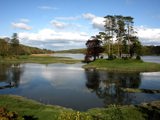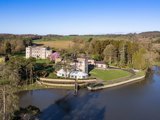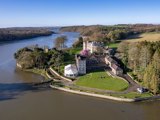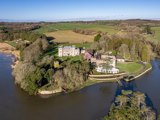About Us
The Slebech Park Estate is set in the heart of the Pembrokeshire National Park in West Wales. The facilities at the Estate revolve around the 18th century Grade II listed coach house, once the centre ofthe traditional agricultural Estate. The Coach house commands a stunning position on the shores of the Daugleddau Estuary, part of one of Europe’s largest natural harbours. The Estate numbers some 650 acres split between arable lands, mature woodlands, fallow meadows and riverside walks.
Our Heritage
The origin of the word Slebech is thought by some to be a Viking word meaning ‘’Stoney Beach’’. It is very probable that the Vikings sailed inland to Slebech on raiding parties, as was customary and on seeing Slebech’s commanding position on the river and the small harbour, saw it as a place of refuge. Slebech holds an important position in the history of Wales; it was a most important meeting point for pilgrims on the way to the Cathedral and monastic grounds of St David’s from the 6th Century onwards. Visited by Kings and Queens of England, including William the Conquer, Henry II, Edward the I and Queen Eleanor to name but a few. The areas of the Estate would have been used according to male or female, rich or poor, we know for example there was a ‘’Beggars’’ field, which would have been for the less well-off and those thought to diseased or unworthy, but alas we have not found it yet! Pope Calixtas decried, (because of the wealth that St David’s bought) that this pilgrimage was the second most important at that time in Christendom, 2 visits was the equivalent to 1 pilgrimage to Rome.
The oldest building still standing today is the Norman tower in our 12th century church. This probably formed part of a watch tower as it is placed in an ideal spot over the turn of the river. This site was linked to the other fine Norman Castles in the area which formed a defensive line across Pembrokeshire as the Normans looked to secure their possessions in this part of West Wales. During the 13th and 14th centuries it was home to the most powerful monastic foundation in Wales. With substantial lands across the country. The hospice was run by the Knights of St John (Formally the Knights Templar, now known as the St John’s Ambulance) Slebech was Wales’s most important meeting point for the gathering of knights as they went on their way to the crusades, in fact Knights killed fighting on foreign fields had their hearts pickled and reburied in the crypt of the Norman church and on Slebech’ s ‘’Dog Island’’ (which is now a ‘’Scheduled Ancient Monument’’ and forms the backdrop of our website) a 12th century sword was found and is now displayed in the Welsh National museum. As a result of the hospice at Slebech, the areabecame an important crossing point of the waterway and had lands on both sides of the river Estuary.
With Henry VIII and the reformation, the powerful Commandery was disbanded and the lands and wealth distributed, probably mostly to Henry himself! The only remnants now are the 12th century church, maybe some of our old tunnels and some thick walls in Slebech hall. Sadly there are no records of the other buildings on site as they were destroyed during the sieges of the English Civil War.
The Estate was sold by the crown to the family of Roger Barlow, who at the time was a powerful Tudor gentlemanand a close friend and confidant of Henry VIII. He was also a bit of an adventurer who set sail with the Spanish fleet on the voyage of discovery to the America’s. The Barlow family continued to own the Slebech until the 18th century. In 1763 Catherine Barlow inherited the Estate from her father. Catherine married Sir William Hamilton but in 1782 she died childless. Sir William married his second wife Lady Emma Hamilton, who later had a well-publicised affair with one of Britain’s greatest hero’s, Lord Nelson. When Sir William died he was buried with his 1st wife Catherine in the old churchyard at Slebech.
The modern era of the Estate and the buildings began around the 1750’s with the building of the current Slebech Hall, one of Wales’s finest Georgian manor houses reputably designed by the famous Georgian architect Antony Ketch, the architect who is also believed to be behind the designs of Highgrove house, home of Prince Charles. At about the same time the modest granary buildings were changed to create a grandiose set of stables and coach houses around the central courtyard, (the present ‘’loose box’’ still has much of its original charming features). As with the Hall the building was ‘’Castellated’’ to give it a more imposing structure, probably inspired by the renovations at the time at nearby Picton castle. Slebech hall retains much of its original features and is Grade 2* listed and plans are being formulated to bring the hall back to its original splendour and to incorporate it into the current hotel operations. The refurbishment of the Estate financially ruined the family and the Estate had various owners over next few years.
The next colourful character in our history was Nathaniel Phillips, a Jamaican sugar plantation owner who also married for money and liked the odd duel or two! He was 65 when he married his second wife, a Phillips from Picton Castle at the tender age of 19.Thus started the connection to Picton next door.
When he passed away his daughter, Mary Dorothea married the slightly eccentric and interestingly named ‘’Baron De Rutzen’’, who liked to spend and had great plans for the Estate, he built the back to front church on the main A40 which is still an imposing building today. The last of his line was John Frederick Foley who was killed in Italy in 1944 during WW2.
During WW2 the Estate, like much of Pembrokeshire, were hosts to the US army as they protected our shores and prepared for D-Day, apparently there is still a Willis jeep in our lake, racing down our drive with the folly of youth is how we like to picture it!.
His widow eventually sold the Estate to the Hon William Phillips who was the father of our previous owner and the man who started the present hotel operation Geoffrey Mark Phillips. The Phillips name slipped quietly into the colourful history of the Estate in 2013 as another new chapter begins here at this beautiful and historic site.
So we hope you can see we really are an historic destination, supplemented by our bespoke bedrooms, graceful dining experience with fine foods and relaxing and meandering walks, in stunning surroundings that have welcomed travellers from around the world for over a thousand years.




